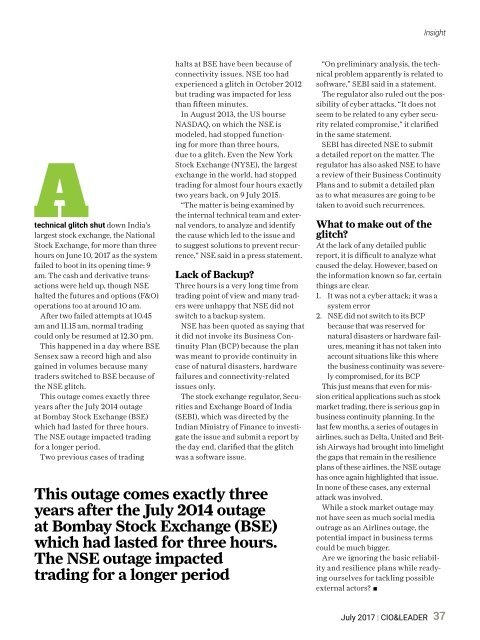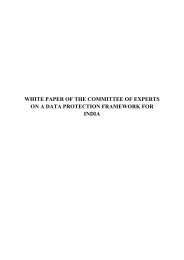CIO&Leader_July 2017 (1)
Create successful ePaper yourself
Turn your PDF publications into a flip-book with our unique Google optimized e-Paper software.
Insight<br />
Atechnical glitch shut down India’s<br />
largest stock exchange, the National<br />
Stock Exchange, for more than three<br />
hours on June 10, <strong>2017</strong> as the system<br />
failed to boot in its opening time: 9<br />
am. The cash and derivative transactions<br />
were held up, though NSE<br />
halted the futures and options (F&O)<br />
operations too at around 10 am.<br />
After two failed attempts at 10.45<br />
am and 11.15 am, normal trading<br />
could only be resumed at 12.30 pm.<br />
This happened in a day where BSE<br />
Sensex saw a record high and also<br />
gained in volumes because many<br />
traders switched to BSE because of<br />
the NSE glitch.<br />
This outage comes exactly three<br />
years after the <strong>July</strong> 2014 outage<br />
at Bombay Stock Exchange (BSE)<br />
which had lasted for three hours.<br />
The NSE outage impacted trading<br />
for a longer period.<br />
Two previous cases of trading<br />
halts at BSE have been because of<br />
connectivity issues. NSE too had<br />
experienced a glitch in October 2012<br />
but trading was impacted for less<br />
than fifteen minutes.<br />
In August 2013, the US bourse<br />
NASDAQ, on which the NSE is<br />
modeled, had stopped functioning<br />
for more than three hours,<br />
due to a glitch. Even the New York<br />
Stock Exchange (NYSE), the largest<br />
exchange in the world, had stopped<br />
trading for almost four hours exactly<br />
two years back, on 9 <strong>July</strong> 2015.<br />
“The matter is being examined by<br />
the internal technical team and external<br />
vendors, to analyze and identify<br />
the cause which led to the issue and<br />
to suggest solutions to prevent recurrence,”<br />
NSE said in a press statement.<br />
Lack of Backup?<br />
Three hours is a very long time from<br />
trading point of view and many traders<br />
were unhappy that NSE did not<br />
switch to a backup system.<br />
NSE has been quoted as saying that<br />
it did not invoke its Business Continuity<br />
Plan (BCP) because the plan<br />
was meant to provide continuity in<br />
case of natural disasters, hardware<br />
failures and connectivity-related<br />
issues only.<br />
The stock exchange regulator, Securities<br />
and Exchange Board of India<br />
(SEBI), which was directed by the<br />
Indian Ministry of Finance to investigate<br />
the issue and submit a report by<br />
the day end, clarified that the glitch<br />
was a software issue.<br />
This outage comes exactly three<br />
years after the <strong>July</strong> 2014 outage<br />
at Bombay Stock Exchange (BSE)<br />
which had lasted for three hours.<br />
The NSE outage impacted<br />
trading for a longer period<br />
“On preliminary analysis, the technical<br />
problem apparently is related to<br />
software,” SEBI said in a statement.<br />
The regulator also ruled out the possibility<br />
of cyber attacks. “It does not<br />
seem to be related to any cyber security<br />
related compromise,” it clarified<br />
in the same statement.<br />
SEBI has directed NSE to submit<br />
a detailed report on the matter. The<br />
regulator has also asked NSE to have<br />
a review of their Business Continuity<br />
Plans and to submit a detailed plan<br />
as to what measures are going to be<br />
taken to avoid such recurrences.<br />
What to make out of the<br />
glitch?<br />
At the lack of any detailed public<br />
report, it is difficult to analyze what<br />
caused the delay. However, based on<br />
the information known so far, certain<br />
things are clear.<br />
1. It was not a cyber attack; it was a<br />
system error<br />
2. NSE did not switch to its BCP<br />
because that was reserved for<br />
natural disasters or hardware failures,<br />
meaning it has not taken into<br />
account situations like this where<br />
the business continuity was severely<br />
compromised, for its BCP<br />
This just means that even for mission<br />
critical applications such as stock<br />
market trading, there is serious gap in<br />
business continuity planning. In the<br />
last few months, a series of outages in<br />
airlines, such as Delta, United and British<br />
Airways had brought into limelight<br />
the gaps that remain in the resilience<br />
plans of these airlines, the NSE outage<br />
has once again highlighted that issue.<br />
In none of these cases, any external<br />
attack was involved.<br />
While a stock market outage may<br />
not have seen as much social media<br />
outrage as an Airlines outage, the<br />
potential impact in business terms<br />
could be much bigger.<br />
Are we ignoring the basic reliability<br />
and resilience plans while readying<br />
ourselves for tackling possible<br />
external actors?<br />
<strong>July</strong> <strong>2017</strong> | CIO&LEADER<br />
37














